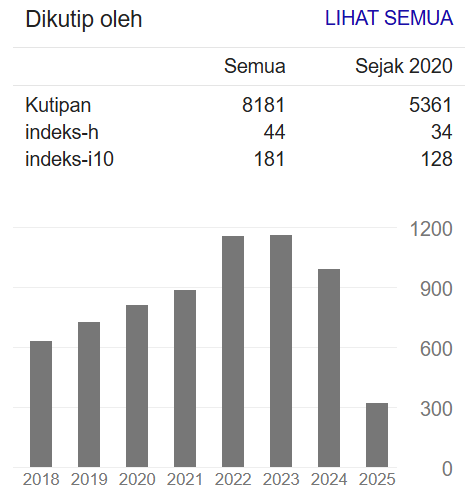IMPELEMENTASI POTENTIAL HAZARDS PELAYANAN RUMAH SAKIT DENGAN MENGGUNAKAN METODE JOB SAFETY ANALYSIS
DOI:
https://doi.org/10.34011/jmp2k.v34i1.1879Keywords:
Job Safety Analysis, Potential hazards hospital servicesAbstract
Potential dangers in hospitals, apart from infectious diseases, there are also other potential dangers, namely accidents, radiation, anesthetic gasses, psychosocial and ergonomic disorders. The study aimed to analyze the implementation of potential dangers of hospital services using the method Job Safety Analysis at the Regional Hospital X. This type of research is descriptive. a sample of 7 people who work in the Emergency Unit, through an approach accidental sampling. The research variable is the potential for danger in the UGD Regional Hospital X. The instrument used is the JSA instrument. The data obtained is presented in the form of a narrative and a matrix of in-depth interview results. Respondents who carry out potentially dangerous work according to the JSA method are doctors and nurses who provide services in the Emergency Unit. The work carried out is lifting and moving patients, giving injections, using ventilators, using EKGs, using monitor units, using section units and workload. Respondents who carry out potentially dangerous work according to the JSA method are doctors and nurses. Potentially dangerous facilities are syringes, ventilators, sections, masks, stethoscopes, cuffs, EKGs, ventilators, section units. For the Regional Hospital X to provide outreach about occupational safety and health management in the hospital to all employees so that they know the risk of work accidents and make an analysis of potential hazard methods according to the JSA method so that doctors and nurses know the level of risk of work accidents when providing services.
References
Efryanti, “Kajian Risiko Keselamatan dan Kesehatan Kerja pada Petugas Kesehatan dan Petugas Kebersihan Klinik X Tahun 2012,” FKM Univ. Indones., Hal. 131, 2012.
Y. Embuai, H. M. Denny, and Y. Setyaningsih, “Analisis Faktor Individu, Pekerjaan dan Perilaku K3 pada Kejadian Penyakit Dekompresi pada Nelayan Penyelam Tradisional di Ambon,” J. Penelit. Kesehat. “SUARA FORIKES” (Journal Heal. Res. “Forikes Voice”), Vol. 11, No. 1, Hal. 6–12, 2020, doi: 10.33846/sf11102.
International Labour Organization, The Prevention of Occupational Diseases, April. 2014.
D. Sarastuti, “Analisis Kecelakaan Kerja di Rumah Sakit Universitas Gadjah Mada Yogyakarta,” FIK Univ. Muhammadiyah Surakarta, Hal. 21, 2016.
I. De Crystal, E. Tri Ardianto, and S. Farlinda, “Analisis Risiko Kerja Petugas Filling Rawat Inap Dengan Menggunakan Severity Assessment di RSUP Dr. Hasan Sadikin Bandung,” J-REMI J. Rekam Med. dan Inf. Kesehat., Vol. 1, No. 3, Hal. 113–119, 2020.
Kementrian Kesehatan RI, “Laporan Riskesdas 2018 Nasional,” Kementerian Kesehatan Republik Indonesia. Jakarta, Hal. 146–379, 2018.
R. Toding, J. M. L. Umboh, and J. Josephus, “Analisis Penerapan Sistem Manajemen Kesehatan Dan Keselamatan Kerja (SMK3) Di Rsia Kasih Ibu Manado,” Pharmacon, Vol. 5, No. 1, Hal. 284–289, 2016.
P. Marfiana, H. K. Ritonga, and M. Salsabiela, “Implementation of Risk Assessment At Filling Fuel Work in Filling Shed Area,” J. Migasian, Vol. 1, No. 2, Hal. 28–35, 2017.
M. D. Pratama Rahman, E. D. Priyana, and A. W. Rizqi, “Job Safety Analysis (JSA) Sebagai Upaya Pengendalian Resiko Kecelakaan Kerja Pada Pekerjaan Fabrication Dd PT. Wilmar Nabati Indonesia,” Tek. Sains J. Ilmu Tek., Vol. 7, No. 2, Hal. 98–109, 2022.
L. Mulyati, D. Rachman, and Y. Herdiana, “Fakor Determinan yang Memengaruhi Budaya Keselamatan Pasien di RS Pemerintah Kabupaten Kuningan Determinant factors that are Influencing Patient Safety Culture in a Government-owned Hospitals in Kuningan Regency,” J. STIKes Kuningan, Vol. 4, No. 2, Hal. 179–190, 2016.
P. Martino, D. I. Rinawati, and R. Rumita, “Analisis Identifikasi Bahaya Kecelakaan Kerja Menggunakan Job Safety Analysis (JSA) Dengan Pendekatan Hazard Identification, Risk Assessment and Risk Control (HIRARC)di PT. Charoen Pokphand Indonesia-Semarang,” Progr. Stud. Tek. Ind. Univ. Diponegoro, 2014.
N. Rosdiana, S. Kirana Anggraeni, A. Umyati, J. Teknik, I. Universitas, and A. Tirtayasa, “Identifikasi Risiko Kecelakaan Kerja Pada Area Produksi Proyek Jembatan Dengan Metode Job Safety Analysis (JSA),” J. Tek. Ind., Vol. 5, No. 1, Hal. 1–6, 2017.
B. A. A. Dharma, I. G. A. A. Putera, and A. A. D. Parami, “Manajemen Risiko Keselamatan Dan Kesehatan Kerja (K3) Pada Proyek Pembangunan Jambuluwuk Hotel & Resort Petitenget,” J. Spektran, Vol. 5, No. 1, Hal. 1–87, 2017.
R. Amni and R. Purwaningsih, “Analisis Potensi Bahaya pada Pekerjaan dengan Menggunakan Metode Job Safety Analysis (JSA) pada Proses Pengolahan Kelapa Sawit PT. Sinergi …,” Semin. dan Konf. Nas. IDEC, Fak. Tek. Univ. Diponegoro, Hal. 1–10, 2021.
D. S. Purnama, “Analisis Penerapan Metode Hirarc (Hazard Identification Risk Assessment and Risk Control) Dan Hazops (Hazard and Operability Study) Dalam Kegiatan Identifikasi Potensi Bahaya Dan Resiko Pada Proses Unloading Unit Di Pt. Toyota Astra Motor,” J. PASTI, Univ. Mercu Buana, Vol. 9, No. 3, Hal. 311–319.
A. Anugerah, “Implementasi Job Safety Analysis (JSA) Pada Kegiatan Finishing di Industri Mebel Kec. Somba Opu, Kab. Gowa,” Fak. Kedokt. dan Ilmu Kesehatan, UIN Alauddin Makassar, 2017.
J. Bawang, P. A. T. Kawatu, and R. Wowor, “Analisis Potensi Bahaya Dengan Menggunakan Metode Job Safety Analysis di Bagian Pengapalan Site Pakal PT. Aneka Tambang Tbk. UBPN Maluku Utara,” J. KESMAS, Fak. Kesehat. Masy. Univ. Sam Ratulangi, Vol. 7, No. 5, Hal. 1–15, 2018.
L. Salawati, N. H. Taufik, and A. Putra, “Analisis Tindakan Keselamatan dan Kesehatan Kerja Perawat dalam Pengendalian Infeksi Nosokomial di Ruang ICU RSUD dr. Zainoel Abidin Banda Aceh,” J. Kedokt. Syiah Kuala, Vol. 14, No. 3, Hal. 128–134, 2014.
W. L. Siagian, “Manajemen Risiko Keselamatan dan Kesehatan Kerja Pada Proses Pengolahan Minyak,” Fak. Ilmu Kesehat. Univ. Sriwij., 2021.




